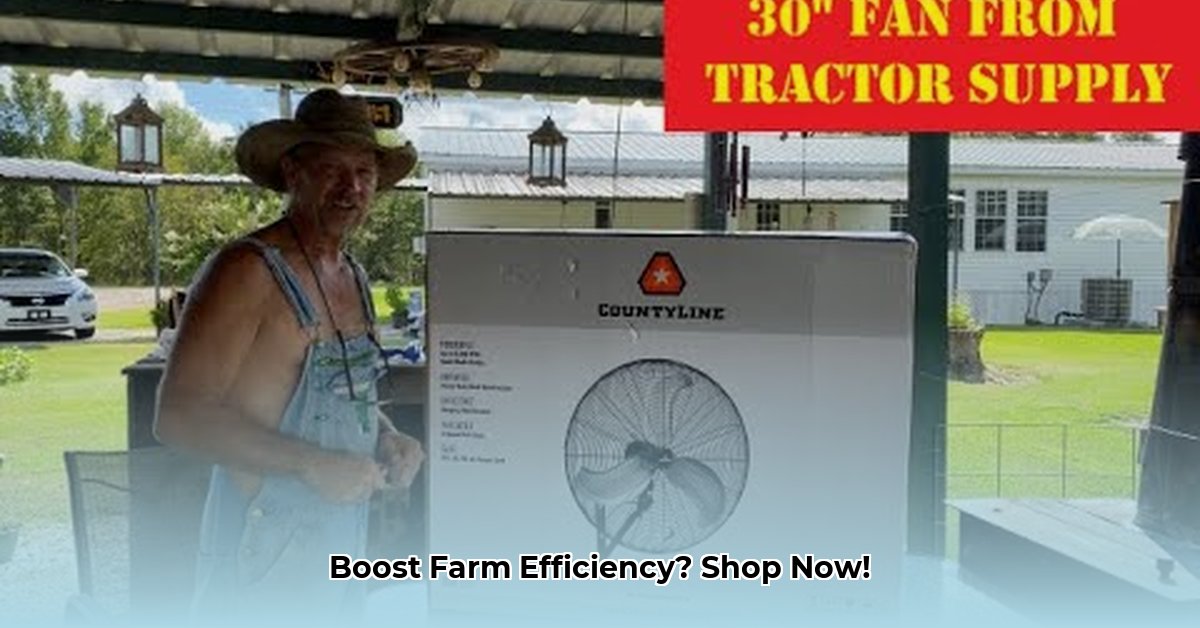
Keeping your farm cool and well-ventilated isn't just about comfort; it's crucial for boosting productivity and ensuring the well-being of your livestock and crops. A well-chosen shop fan from Tractor Supply can significantly improve your farm's efficiency and contribute to sustainable practices. But with so many options, how do you choose the right one? This guide will walk you through the process, helping you select the perfect fan to meet your specific needs and budget. For sustainable fuel options, consider checking out pine pellet options.
Choosing the Right Shop Fan for Your Agricultural Needs
Selecting the right shop fan involves careful consideration of several key factors. Let's break this down step-by-step.
1. Identifying Your Application: What's your primary goal? Are you focusing on livestock cooling within a barn, optimizing airflow in a greenhouse, improving crop drying efficiency, or perhaps cooling down equipment after a long workday? The intended application significantly impacts the type of fan you'll need. A high-velocity fan is ideal for large barns, while a smaller pedestal fan might suffice for targeted cooling in a more confined space. Don't you want to maximize your investment by selecting a fan perfectly suited to its task?
2. Assessing Your Space: Accurately measure the area you need to ventilate. Cubic footage is crucial for determining the necessary airflow. Larger spaces require fans with a higher cubic feet per minute (CFM) rating to ensure adequate ventilation. Tractor Supply's website or knowledgeable staff can assist you in calculating the appropriate CFM for your specific space. Remember, it's always advisable to slightly overestimate airflow needs to ensure optimal results.
3. Power Source: Electric vs. Gas: Electric fans are generally more convenient and often more energy-efficient in the long run, making them a more sustainable choice. However, gas-powered options offer superior portability, proving invaluable in remote locations lacking reliable electricity. Which option best aligns with your farm's infrastructure and long-term cost considerations? The initial cost might be lower for a gas-powered fan, but the ongoing energy costs should be factored into your decision.
4. Budgetary Considerations: Tractor Supply offers a wide range of fans at varying price points. Establishing a clear budget before you start shopping is essential. Prioritize essential features such as durability and energy efficiency, rather than focusing on superfluous features. A more durable and energy-efficient fan might have a higher upfront cost but will likely translate to significant long-term savings through reduced energy bills and a longer lifespan.
5. Durability and Lifespan: While the initial purchase price is important, consider the fan's anticipated lifespan. A robust fan constructed from high-quality materials will generally last longer, reducing the frequency of replacements. This contributes to overall long-term cost savings and minimizes waste, aligning perfectly with sustainable farming practices.
Exploring the Variety of Shop Fans at Tractor Supply
Tractor Supply provides a diverse selection of shop fans, each catering to specific needs. Understanding their advantages and disadvantages will empower you to make an informed decision.
| Fan Type | Advantages | Disadvantages | Ideal Applications |
|---|---|---|---|
| High-Velocity Fans | Powerful airflow, efficient cooling of large spaces. | Can be noisy; less versatile for diverse applications. | Large barns, equipment cooling, substantial ventilation needs |
| Pedestal Fans | Portable and adjustable height for flexible placement. | Lower airflow than high-velocity fans; less durable. | Smaller spaces, targeted cooling, areas requiring mobility. |
| Box Fans | Compact and ideal for moving air in confined areas. | Less powerful than other options; generally less durable. | Ventilation in small barns, greenhouses, workshops. |
| Industrial Fans | Extremely durable, high airflow, often high horsepower. | Higher cost; may require professional installation. | Large-scale operations, industrial agricultural settings. |
Installation, Maintenance, and Safety: Best Practices
Installation:
- Safety First: Always disconnect the power source before commencing installation.
- Secure Mounting: Use appropriate mounting hardware specifically designed for your chosen fan model. Carefully verify the weight limits of the mount to prevent accidents.
- Electrical Wiring (if applicable): Adhere meticulously to the manufacturer's instructions for electrical wiring to ensure both safe and effective operation.
- Stability Check: After installation, ensure the fan is stable and secure before operating it.
Maintenance:
- Regular Cleaning: Clean the fan blades regularly to maintain optimal airflow and prevent dust accumulation, which can negatively impact efficiency.
- Inspection for Loose Parts: Periodically check for loose screws, bolts, or other components, tightening them as needed.
- Cord Inspection: Regularly inspect the power cord for any signs of damage such as fraying or cuts. Replace damaged cords immediately to prevent electrical hazards.
Safety Precautions:
- Keep fans away from water or flammable materials.
- Avoid touching moving parts.
- Always use GFCI (Ground Fault Circuit Interrupter) protected outlets in damp environments.
- Regularly inspect cords for wear and tear.
Investing in energy-efficient shop fans from Tractor Supply offers substantial benefits beyond mere comfort; it's a significant step toward sustainable and profitable farming. Improved ventilation enhances livestock well-being, reduces spoilage and waste, and contributes to a healthier, more efficient operation. Remember to choose a model that perfectly aligns with your specific requirements and budget to maximize its impact on your farm's long-term success and environmental footprint.